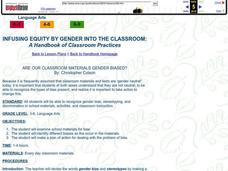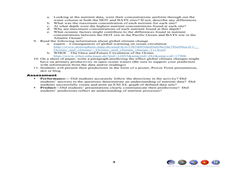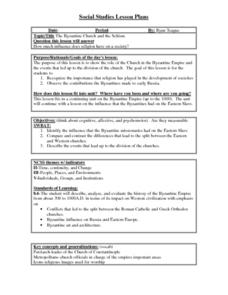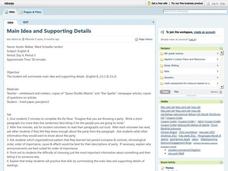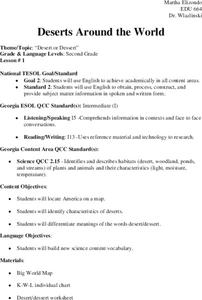Curated OER
Reading Word Recognition, Fluency, and Vocabulary
Eleventh graders analyze words that derive meaning from Greek, Roman, and Norse myths. In this myth vocabulary lesson, 11th graders work in learning groups as visual learners, kinesthetic learners, and artistic learners to identify the...
Curated OER
More Amazing Americans: A WebQuest
Students research amazing Americans using America's Library. For this American heroes lesson, students identify criteria for amazing Americans. Students copy and paste text and graphics from websites to use in their own documents....
Curated OER
Are Our Classroom Materials Gender Biased?
Students explore equality by analyzing their own classroom belongings. In this gender bias instructional activity, students investigate their classroom and identify objects as either male or female biased. Students collaborate while...
Curated OER
Sharing the Joy of a Garden
Students see that a garden is a place where an individual can go for inner peace and solitude. They discover that a garden is to be shared. Students describe the importance that a garden has to the environment and lives of individuals...
Curated OER
Bats and Hot Dogs
Students identify patterns and relationships from data that is collected and solve variables. In this investigative lesson students study ocean productivity, the nitrogen cycle and phytoplankton then answer questions.
Curated OER
Freshwater Macroinvertebrates
Students identify and count Macroinvertebrates at a Hydrology website. In this macroinvertebrates lesson students collect, sort and identify Macroinvertebrates.
Curated OER
Graphing Real World Situations
Students solve linear equations using graphs. In this algebra lesson, students depict real life situation using lines and functions. They identify the slope, data and predict graphing behavior.
Curated OER
Pennsylvania Dutch Hex Signs
Young scholars experience Pennsylvania Dutch culture and heretige as they identify and create Hex signs based on unity, focal point, nature and a personal meaning.
Alabama Learning Exchange
Would you fit in with the Cherokees?
Students use this activity as an introduction to the unit on Cherokee Native Americans. They discuss and research Cherokee dress and homes and identify difference between the Cherokee and the individuals in the class.
Curated OER
Science: The Bicycle as a System
Students explore how the different parts of a bicycle relate to each other and identify the subsystems. They discover how bicycles work and investigate their history. In groups, students research each of the subsystems and present...
Curated OER
Historical Maryland Women
Learners identify objects, activities, and people in pictures of women in Maryland's history. In groups of four, they analyze photo packets of historical women. Students complete an acrostic using phrases reflecting specific...
Curated OER
Invertebrates
Learners identify the characteristics common to all animals. In groups, they compare the characteristics between the animals and how they are divided. To end the lesson, they compare the eight phyla of invertebrates and review the...
Curated OER
Beauty is More Than Skin Deep: Examining the Positive and Negative Depictions of Physical Appearance in Children's Films
Third graders compare and contrast different versions of the same story. They recognize our differences, identify qualities that make us special and unique individuals, and create a 'Wanted' poster illustrating a special quality.
Curated OER
Simple machines
Students list and describe the six simple machines. They create a Thinking Map and outline using Kidspiration and create a paper on the importance of simple machines using Microsoft Word.
Curated OER
Proper Hygiene
Third graders discuss the importance of personal hygiene and cleanliness. They examine why good oral hygiene is a significant part of maintaining a healthy body. They focus on the need for daily baths, hair care, and teeth cleaning. They...
Curated OER
Get Out the Vote!
Students discuss importance of voting within a democracy, and investigate reasons why people vote, and why they don't. Students then conduct survey, make hypotheses about voter motivation, and develop materials to promote voting among...
Curated OER
The Byzantine Church and the Schism
Students examine the role of the church in the Byzantine Empire, and the importance that relgion has played in the development of socieites. They research the events that led up to the division of the Byzantine church, and the...
Curated OER
Main Idea and Supporting Details
Eighth graders identify the main idea and supporting details in paragraphs. In this language arts lesson, 8th graders review organizational patterns in paragraphs and determine which pattern is best for a given situation. Individually,...
Curated OER
Civil War Trading Cards
Learners research important figures in the American Civil War. In this research skills lesson, students create trading cards about selected key figures in the war that list details about the figures and their accomplishments.
Curated OER
Surface Area of Prisms
Learners calculate the surface area of different prisms. In this geometry lesson, students identify the shapes of solids based on the properties of that solid. They calculate the surface area using nets and properties of prisms.
Curated OER
Conservation 'Ad'vice for National Parks
Young scholars discuss ways that the public can damage as well as preserve our natural and cultural resources. Small groups are each assigned one of the national parks and must design a poster or TV commercial that celebrates the...
Curated OER
Sound All Around Us
Students make predictions about how sound is formed. They view and discuss a video that explores sound formation and attempt to identify the origin of different sounds.
Curated OER
Twig Match
Learners practice observing and identifying the characteristics of twigs. They attempt to identify trees after their leaves have fallen off. They describe the twigs and participate in a matching activity with the twigs and student...
Curated OER
Deserts Around the World
Second graders explore the deserts around the world. They use a map and locate America on the map. Students discuss and identify the characteristics of deserts and differentiate the meanings of the word desert and dessert. Students...


